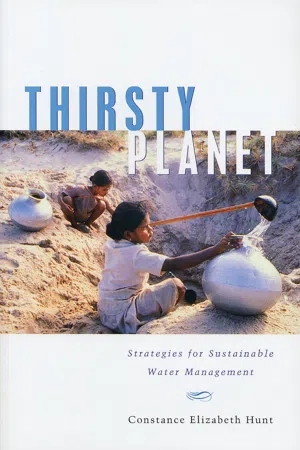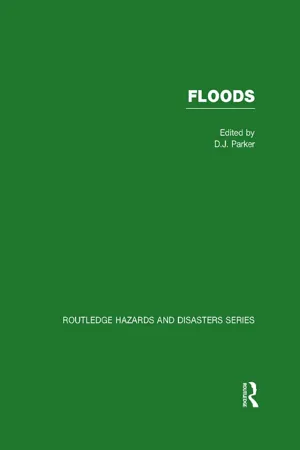Geography
Flooding
Flooding is a natural disaster that occurs when water overflows onto land that is normally dry. It can be caused by heavy rainfall, snowmelt, or a combination of both. Flooding can have devastating effects on communities, causing damage to homes, businesses, and infrastructure.
Written by Perlego with AI-assistance
Related key terms
1 of 4
Related key terms
1 of 3
3 Key excerpts on "Flooding"
- eBook - ePub
Thirsty Planet
Strategies for Sustainable Water Management
- Constance Elizabeth Hunt(Author)
- 2013(Publication Date)
- Zed Books(Publisher)
5 When It Rains, It Pours Water Management for Flood Damage ReductionTHE NATURE AND HISTORY OF FLOODS‘One central problem is that many of the accepted methods for coping with hazards have been based on the idea that people can use technology to control nature to make themselves safe. What’s more, most strategies for managing hazards have followed a traditional planning model: study the problem, implement one solution, and move on to the next problem. This approach casts hazards as static and mitigation as an upward, positive, linear trend.‘But events during the past quarter-century have shown that natural disasters and the technological hazards that may accompany them are not problems that can be solved in isolation. Rather, they are symptoms of broader and more basic problems. Losses from hazards – and the fact that the nation cannot seem to reduce them – result from shortsighted and narrow conceptions of the human relationship to the natural environment.’1In general terms, the inundation of land that is usually dry is considered a flood. The term ‘normally dry’ is open to interpretation, but in the case of rivers might generously include any inundation of land outside the banks of the river. The banks are defined by ‘channel-forming’ or ‘dominant discharge’ flows, which occur once every year or two on average for perennial streams in humid climates and every ten years on average in arid climates.2 Flows that overtop the bank are only slightly less frequent than channel-forming flows.Floods are natural events that usually result from heavy rainfall or snowmelt over a watershed. Most of the large rivers in the world have slightly to extremely periodic flows, with pronounced high flows once or twice a year. Monsoons are caused by wind systems that reverse their direction because of the seasonal change from high pressure to low pressure over large continental areas. The Indian subcontinent, where the monsoon is particularly strong, becomes very hot in the summer, allowing a strong low-pressure cell to develop. Humid air moving in from the ocean carries high rainfall with it. The southward-shifting Inter-Tropical Convergence Zone has a similar effect during the summer in the Southern Hemisphere, causing seasonal rains in subtropical southern Africa. The development of destructive hurricanes and typhoons is connected with extreme cases of convective rains that develop in subtropical areas when low-pressure convective cells form over sea surfaces warmer than 26 degrees centigrade. Regional deviations in global precipitation patterns also result from orographic effects. High rainfall usually occurs on the side of the cell where air is forced upward and low rainfall where the air mass moves down.3 - eBook - ePub
Global Hydrology
Processes, Resources and Environmental Management
- J. A. A. Jones(Author)
- 2014(Publication Date)
- Routledge(Publisher)
As we discuss the nature and causes of floods and droughts, it is necessary to begin by considering their definition. Both are remarkably difficult to define. This is partly because in nature there are no real breaks in flows and partly because the thresholds that are selected are defined in terms of human requirements, which vary.4.1.1 FloodsAs commonly understood, a flood occurs when a river overtops or ‘bursts’ its banks and flows across the floodplain. To the hydrologist, however, this is just a flow which exceeds a particular level; albeit an extremely important one in nature and for human occupancy of the floodplain. This bankfull level is also only one of many levels or thresholds that could be selected as being critical for some particular purpose. Engineers, planners and insurers are often more concerned with floods that exceed some other, higher level that is more critical to flood defences, and they seek to predict how often that higher level will be exceeded. For agricultural purposes, the depth of Flooding may not determine the extent of damage as much as the length of the inundation or the season.In practice, the bankfull level is often difficult to define, not least because the height of the banks varies along the river. Similarly, the depth of flow is only one component of the discharge. The same bank height may not accommodate the same discharge, since the discharge that a channel can contain also depends on the width and slope of the channel. As a result, the same discharge may inundate some stretches of the floodplain and not others.It is scientifically better to define a flood in terms of the discharge. Hence, hydrologists can refer to ‘flood flows’ when no real ‘Flooding’ has occurred. The highest flow in any one year is called the ‘annual flood’ whether it ‘bursts’ the banks or not. In this sense, the term is used synonymously with peak discharges.In rivers, floods and low flows are usually expressions of the temporal variability in rainfall or snowmelt interacting with river basin characteristics. These characteristics can be broadly divided into: (1) overall basin form; (2) hillslope properties; and (3) channel network properties (Figure 4.1 - jökulhlaups . He concludes with an analysis of factors influencing flood frequencies, including global warming.Scientific knowledge about the causes of floods is advancing, although Cordery and Pilgrim (see Chapter 39 ) are sanguine about the pace of this progress. In the subsequent chapter, Chapter 35 , Tony Jones takes the analysis further by focusing upon the ways in which human activities, such as land clearance, agricultural activity, urbanisation and channel modification, alter flood-producing processes and the evidence from scientific, experimental catchment studies. Human activity, particularly deforestation, is often accused of causing and intensifying flood hazards. However, the scientific evidence is much more discriminating about these effects and the direction in which they work. In practice, flood risk is both inadvertently increased and reduced, and some approaches (e.g. afforestation) generally believed to reduce flood risk may actually increase it in some circumstances. The scientific evidence relating to the worsening effects of urbanisation on floods is clearer than for deforestation, and the draining of wetlands is also now widely acknowledged to have exacerbated floods. Tony Jones discusses the important methodological and data problems underlying experimental catchment studies and, through the wide range of evidence cited, demonstrates how hazardous it can be to generalise about those human activities which increase and reduce flood frequency, magnitude and timing.Both Richard Warrick et al . (Chapter 36 ) and Robert Nicholls (Chapter 37 ) focus on the developing and likely future implications of global warming and sea-level rise for the occupation of coastal zones and coastal Flooding. Globally, population and urbanisation are growing fastest in our coastal zones, which are the very zones that are most susceptible to intensifying sea flood problems. Warrick et al.
Index pages curate the most relevant extracts from our library of academic textbooks. They’ve been created using an in-house natural language model (NLM), each adding context and meaning to key research topics.
Explore more topic indexes
Explore more topic indexes
1 of 6
Explore more topic indexes
1 of 4


